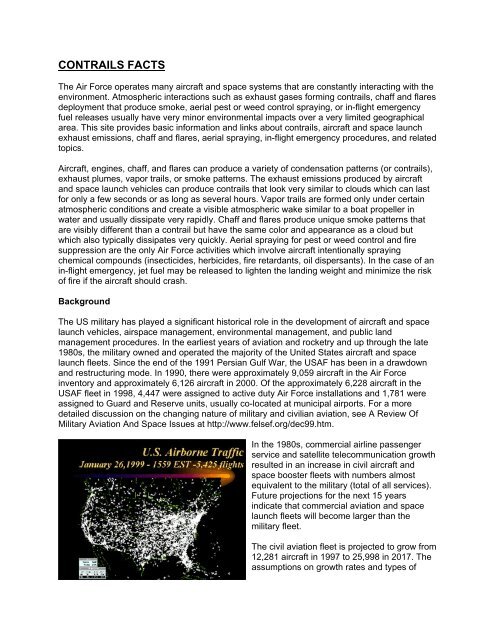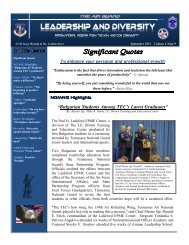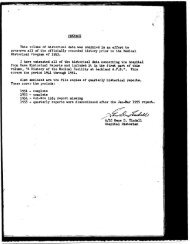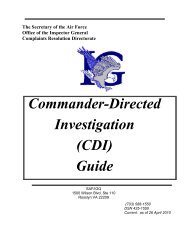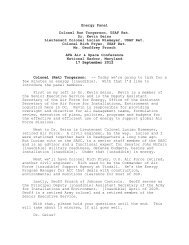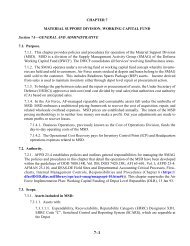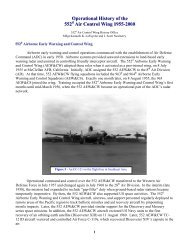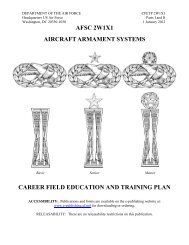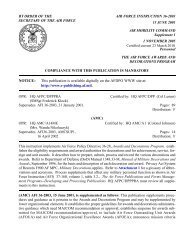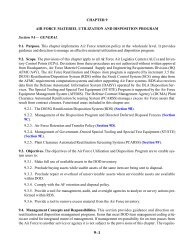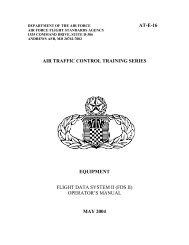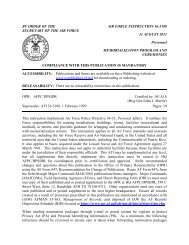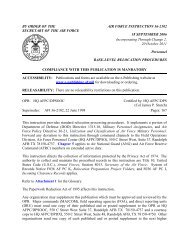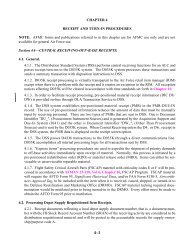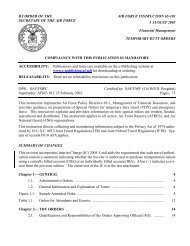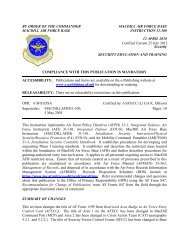CONTRAILS FACTS - Air Force Link
CONTRAILS FACTS - Air Force Link
CONTRAILS FACTS - Air Force Link
- TAGS
- contrails
- link
- www.af.mil
You also want an ePaper? Increase the reach of your titles
YUMPU automatically turns print PDFs into web optimized ePapers that Google loves.
<strong>CONTRAILS</strong> <strong>FACTS</strong><br />
The <strong>Air</strong> <strong>Force</strong> operates many aircraft and space systems that are constantly interacting with the<br />
environment. Atmospheric interactions such as exhaust gases forming contrails, chaff and flares<br />
deployment that produce smoke, aerial pest or weed control spraying, or in-flight emergency<br />
fuel releases usually have very minor environmental impacts over a very limited geographical<br />
area. This site provides basic information and links about contrails, aircraft and space launch<br />
exhaust emissions, chaff and flares, aerial spraying, in-flight emergency procedures, and related<br />
topics.<br />
<strong>Air</strong>craft, engines, chaff, and flares can produce a variety of condensation patterns (or contrails),<br />
exhaust plumes, vapor trails, or smoke patterns. The exhaust emissions produced by aircraft<br />
and space launch vehicles can produce contrails that look very similar to clouds which can last<br />
for only a few seconds or as long as several hours. Vapor trails are formed only under certain<br />
atmospheric conditions and create a visible atmospheric wake similar to a boat propeller in<br />
water and usually dissipate very rapidly. Chaff and flares produce unique smoke patterns that<br />
are visibly different than a contrail but have the same color and appearance as a cloud but<br />
which also typically dissipates very quickly. Aerial spraying for pest or weed control and fire<br />
suppression are the only <strong>Air</strong> <strong>Force</strong> activities which involve aircraft intentionally spraying<br />
chemical compounds (insecticides, herbicides, fire retardants, oil dispersants). In the case of an<br />
in-flight emergency, jet fuel may be released to lighten the landing weight and minimize the risk<br />
of fire if the aircraft should crash.<br />
Background<br />
The US military has played a significant historical role in the development of aircraft and space<br />
launch vehicles, airspace management, environmental management, and public land<br />
management procedures. In the earliest years of aviation and rocketry and up through the late<br />
1980s, the military owned and operated the majority of the United States aircraft and space<br />
launch fleets. Since the end of the 1991 Persian Gulf War, the USAF has been in a drawdown<br />
and restructuring mode. In 1990, there were approximately 9,059 aircraft in the <strong>Air</strong> <strong>Force</strong><br />
inventory and approximately 6,126 aircraft in 2000. Of the approximately 6,228 aircraft in the<br />
USAF fleet in 1998, 4,447 were assigned to active duty <strong>Air</strong> <strong>Force</strong> installations and 1,781 were<br />
assigned to Guard and Reserve units, usually co-located at municipal airports. For a more<br />
detailed discussion on the changing nature of military and civilian aviation, see A Review Of<br />
Military Aviation And Space Issues at http://www.felsef.org/dec99.htm.<br />
In the 1980s, commercial airline passenger<br />
service and satellite telecommunication growth<br />
resulted in an increase in civil aircraft and<br />
space booster fleets with numbers almost<br />
equivalent to the military (total of all services).<br />
Future projections for the next 15 years<br />
indicate that commercial aviation and space<br />
launch fleets will become larger than the<br />
military fleet.<br />
The civil aviation fleet is projected to grow from<br />
12,281 aircraft in 1997 to 25,998 in 2017. The<br />
assumptions on growth rates and types of
aircraft are dependent on many changes in air traffic control, airspace management, and<br />
economic growth, but the general trend for civil aviation is increasing capacity by adding more<br />
frequent flights with smaller regional jets.<br />
<strong>Air</strong>craft fly along specific routes and corridors called the National <strong>Air</strong>space System (NAS). The<br />
NAS is comprised of the air navigation routes and infrastructure across the United States that<br />
supports approximately 60,000 daily flights of commercial, general aviation, and military flights.<br />
The FAA is the lead federal agency charged with the operations and maintenance of the NAS.<br />
They manage over 5-million square miles of land routes and 23-million square miles of oceanic<br />
routes. The FAA must balance the safety and efficiency of the NAS on a daily basis. Many<br />
agencies and organizations are involved with the National <strong>Air</strong>space System for a variety of<br />
purposes: civil air carriers, general aviation, military services, and research organizations. A<br />
typical snapshot of daily aircraft operations in the United States is shown below.<br />
In the last ten years, there has been tremendous growth in the number of aircraft operated<br />
around the world. The majority of aircraft seen overhead are civilian flights, particularly near<br />
large cities. For a more detailed description of the NAS, see A Review Of Military Aviation And<br />
Space Issues: Aerospace And <strong>Air</strong>space (Part II) at http://www.felsef.org/jan00.htm.<br />
Condensation Trails ("contrails")<br />
from <strong>Air</strong>craft Engine Exhaust<br />
Contrails (short for "condensation<br />
trails") are line-shaped clouds<br />
sometimes produced by aircraft<br />
engine exhaust. The combination of<br />
high humidity and low temperatures<br />
that often exists at aircraft cruise<br />
altitudes allows the formation of<br />
contrails. Contrails are composed<br />
primarily of water (in the form of ice<br />
crystals) and do not pose health<br />
risks to humans. Contrails have<br />
been a normal effect of aviation<br />
since its earliest days. Depending<br />
on the temperature and the amount<br />
of moisture in the air at the aircraft<br />
altitude, contrails can either<br />
evaporate quickly or they can persist and grow. Engine exhaust produces only a small portion of<br />
the water that forms ice in persistent contrails. Persistent contrails are mainly composed of<br />
water naturally present along the aircraft flight path.<br />
<strong>Air</strong>craft engines emit water vapor, carbon dioxide (CO2), small amounts of nitrogen oxides<br />
(NOx), hydrocarbons, carbon monoxide, sulfur gases, and soot and metal particles formed by<br />
the high-temperature combustion of jet fuel during flight. Of these emittants, only water vapor is<br />
necessary for contrail formation. Sulfur gases are also of potential interest because they lead to<br />
the formation of small particles. Particles suitable for water droplet formation are necessary for<br />
contrail formation. Initial contrail particles, however, can either be already present in the<br />
atmosphere or formed in the exhaust gas. All other engine emissions are considered<br />
nonessential to contrail formation.
For a contrail to form, suitable<br />
conditions must occur immediately<br />
behind a jet engine in the expanding<br />
engine exhaust plume. A contrail will<br />
form if, as the exhaust gases cool<br />
and mix with surrounding air, the<br />
humidity becomes high enough (or,<br />
equivalently, the air temperature<br />
becomes low enough) for liquid<br />
water to condense on particles and<br />
form liquid droplets. If the local air is<br />
cold enough, these newly formed<br />
droplets then freeze and form ice<br />
particles that make up a contrail.<br />
Because the basic processes are<br />
very well understood, contrail formation for a given aircraft flight can be accurately predicted if<br />
atmospheric temperature and humidity conditions are known.<br />
After the initial formation of ice, a<br />
contrail evolves in one of two ways.<br />
If the humidity is low, the contrail will<br />
be short-lived. Newly formed ice<br />
particles will quickly evaporate. The<br />
resulting contrail will extend only a<br />
short distance behind the aircraft. If<br />
the humidity is high, the contrail will<br />
be persistent. Newly formed ice<br />
particles will continue to grow in size<br />
by taking water from the surrounding<br />
atmosphere. The resulting lineshaped<br />
contrail extends for large<br />
distances behind an aircraft.<br />
Persistent contrails can last for<br />
hours while growing to several<br />
kilometers in width and 200 to 400<br />
meters in height. Contrails spread<br />
because of air turbulence created by<br />
the passage of aircraft, differences<br />
in wind speed along the flight track,<br />
and possibly through effects of solar<br />
heating.<br />
Thus, the surrounding atmosphere’s<br />
conditions determine to a large<br />
extent whether or not a contrail will<br />
form after an aircraft’s passage, and<br />
how it evolves. Other factors that<br />
influence contrail formation include<br />
engine fuel efficiency, which affects<br />
the amount of heat and water<br />
emitted in the exhaust plume.
Contrails become visible roughly about a wingspan distance behind the aircraft. Contrails can<br />
be formed by propeller or jet turbine powered aircraft. During WWII, large formations of bombers<br />
left strikingly remarkable contrail formations. Typical contrails are shown below.<br />
The contrails formed by the exhaust at high altitude are typically white and very similar to cirrus<br />
clouds. As the exhaust gases expand and mix with the atmosphere, the contrail diffuses and<br />
spreads. It is very difficult to distinguish aged contrails from cirrus clouds. It is very difficult to<br />
distinguish aged contrails from cirrus clouds. At sunsets, these contrails can be visibly eyecatching<br />
and striking as they reflect the blue, yellow, and red spectrum of the reflected sunlight.<br />
Persistent contrails are of interest to<br />
scientists because they affect the<br />
cloudiness of the atmosphere.<br />
Scientists in the United States,<br />
Europe, and elsewhere have studied<br />
contrail formation, occurrence, and<br />
persistence, and research efforts on<br />
these topics continue. Shown below<br />
is a photo taken from the research<br />
aircraft Falcon of the German<br />
Aerospace Center (Deutsches<br />
Zentrum fh r Luft- und Raumfahrt<br />
(DLR) at about flight level 33,300<br />
feet of an <strong>Air</strong>bus A340 with contrails<br />
(left) and a Boeing 707 without<br />
contrails (right). This illustrates a<br />
scientific effort to evaluate the<br />
effects of different engine<br />
characteristics on contrail formation.<br />
The <strong>Air</strong> <strong>Force</strong> uses a Boeing 707 airframe for the KC-135 refueling and E-3 AWACS aircraft.<br />
The KC-135 fleet is in the process of upgrading to newer engines which produce fewer<br />
emissions and noise.Scientific research on contrails was recently summarized by an<br />
international group of experts. This summary can be found in Chapter 3 of the report, "Aviation<br />
and the Global Atmosphere," published in 1999 by Cambridge University Press for the<br />
Intergovernmental Panel on Climate Change (IPCC). The report describes current knowledge<br />
regarding the effects of aircraft emissions on the global atmosphere. The full report is available<br />
from Cambridge University Press and a summary of this report is at www.ipcc.ch.<br />
Wingtip Condensation Trails
A different type of contrail or condensation trail is caused when a wing surface or winglet causes<br />
a cavitation of air in very humid conditions. This results in a unique vapor trail that is not formed<br />
due to exhaust gases. The next time you fly in a commercial aircraft through a rain cloud, look<br />
for the vapor trails that form over and around the wing. Typical fighter wingtip contrails are<br />
shown below.<br />
Exhaust Gases and Emissions<br />
Often, military aircraft can be seen taking off with a black smoke appearing from the engines.<br />
This smoke is mainly soot particles, similar to diesel engines. Commercial aircraft also produce<br />
the same type of soot particles, but usually not to the same degree as military aircraft. This is for<br />
two reasons: the type of fuel and the type of engines.<br />
Most military aircraft use JP-8 jet fuel which is a blend of commercial Jet Aviation Fuel -1 (or Jet<br />
A-1) with three extra additives. The additives are used to control ice formation, control biogrowth<br />
(molds and slimes), and inhibit corrosion. The military uses these additives because of the<br />
unique environments the military operates in, the type of self-sealing fuel tanks used, and the<br />
type of metals, plastics, and sealant used on military aircraft. Several specialized aircraft like the<br />
SR-71 and U-2 use different fuels than JP-8, but are developed from the same base stock.<br />
Fuels research is always ongoing. The newest fuel being brought into production is JP-8+100.<br />
Dubbed JP-8+100 because the additive package can increase the thermal stability of military<br />
fuel by 100 degrees Fahrenheit, the improved fuel helps prevent gums and deposits that can<br />
foul fuel lines.<br />
Military engines are also designed with different performance characteristics than commercial<br />
aircraft. Military aircraft and engines also tend to be older and less efficient than commercial<br />
aircraft and produce more emissions. Engines are optimized for fuel consumption and power<br />
rates at a particular cruising altitude. At take-off, the engines are usually very inefficient and<br />
produce more emissions than when at the optimal cruising altitude. Older military aircraft like the<br />
B-52 and C-130 can leave a black smoke exhaust even at cruising altitude, while aircraft like the<br />
KC-135R with new engines produce an invisible exhaust plume. Typical pictures of aircraft<br />
exhaust emission are shown below.<br />
Space launch vehicles and missiles produce a different type of exhaust than aircraft. The<br />
propulsion system on military rockets and missiles is usually made of solid rocket fuel. Missiles<br />
and rockets produce smoke plumes as a result of the solid fuel burning. The hot gases escaping<br />
from the motor can also create contrails, but the smoke and contrail combine to form a single<br />
exhaust plume. For more information on <strong>Air</strong> <strong>Force</strong> propulsion and fuels programs, see the <strong>Air</strong><br />
<strong>Force</strong> Research Laboratory Propulsion Directorate at http://www.pr.afrl.af.mil/.
Chaff and Flares<br />
Chaff and flares are defensive counter measures used on aircraft to confuse radar and heat<br />
seeking missiles. Chaff is used as a decoy for radar seeking missiles and is made of glass<br />
silicate fibers with an aluminum coating. The fibers are approximately 60% glass fiber and 40%<br />
aluminum by weight. The typical <strong>Air</strong> <strong>Force</strong> RR-188 chaff bundle contains about 150 g of chaff or<br />
about 5 million fibers. The fibers are 25 microns in diameter and typically 1 to 2 cm in length. In<br />
1997, the <strong>Air</strong> <strong>Force</strong> used about 1.8 million bundles worldwide.<br />
The amount of chaff released worldwide by all of the services is approximately 500 tons per<br />
year. Chaff falls to the earth at a settling velocity of approximately 30 cm per second.<br />
Atmospheric residence times range from 10 minutes for the majority of chaff released at 100 m<br />
to approximately 10 hours for chaff released at 10,000 feet. Chaff fibers experience little<br />
breakup before reaching the ground.<br />
After the chaff is ejected from the aircraft and into the aircraft slipstream, the chaff packages<br />
burst open and the fibers scatter to form a radar-reflective cloud called a chaff corridor. Each<br />
chaff package is designed to simulate an aircraft. Several aircraft can create a chaff curtain,<br />
consisting of thousands of false targets, which confuse the radar guidance package on a missile<br />
so they are unable to locate the real targets within the chaff cloud.<br />
Virtually all chaff fibers are 10-100 times larger than PM10 and PM2.5, the air particulates of<br />
concern for public health. The primary fiber size is usually too large to be inhaled by livestock,<br />
but if they are inhaled they do not penetrate far into the respiratory system and can be easily<br />
cleared out. The possible nutritional effects due to chaff ingestion and the risk is minimal to nil<br />
for both humans and livestock, considering the chemical composition of chaff (essentially<br />
identical to soil) and low chaff loading on the environment. Chaff decomposing in water has no<br />
adverse impacts on water chemistry or aquatic life.<br />
Flares are of two types: decoy flares that protect aircraft from infrared missiles, and ground<br />
illumination flares. Decoy flares are typically made of magnesium that burns white-hot and are<br />
designed to defeat a missile's infrared (IR) tracking capability. The intense heat of the
pyrotechnic candle consumes the flare housing. Common aerial flares are: ALA-17/B, M-206,<br />
MJU-2, MJU-7 A/B, MJU-10/B, MJU-23/B, and RR-119.<br />
Ground illumination flares, are designed to descend by parachute and provide up to 30 minutes<br />
of illumination of ground targets or activities. Typical flares are the LUU-1, LLU-5, and LLU-2B.<br />
A typical LLU-2B sectional is shown below.<br />
The ground illumination flare enhances a pilot's ability to see targets while using Night Vision<br />
Goggles (NVGs). Flares burn at uneven rates and fluctuate in brightness and are not used as<br />
frequently as in the past as the intense light interferes with the newer NVGs more sensitive<br />
sensors.<br />
The composition and materials of flares used by the military are similar to standard flares used<br />
for aerial, highway and marine purposes. (Skyline). While unburned decoy flares falling from<br />
high altitude could be dangerous, flares are designed to burn up during the descent (even the<br />
aluminum casing is burned).<br />
Chaff and flares are deployed on most <strong>Air</strong> <strong>Force</strong> aircraft from a common MJU-11 Chaff/Flare<br />
magazine that is integrated with the warning receiver (a device that alerts the aircraft a missile<br />
has locked onto the aircraft). The magazine has a capacity of 30 RR-188 or 30 M-206 flares.<br />
A very thorough independent description of military systems, equipment, and capabilities is<br />
published by the American Federation of Scientists.<br />
Typical chaff and flare deployments and patterns are shown in the following pictures.
Aerial Spraying<br />
There are some specific uses of commercial, private, and military aviation where chemicals are<br />
introduced in the atmosphere. The most common association of aerial chemical release is<br />
spraying for insects, either as crop dusting or mosquito prevention measures. These activities<br />
are typically performed at low altitude levels and produce a mist spray that drops to the earth’s<br />
surface.<br />
The only unit in the <strong>Air</strong> <strong>Force</strong> capable of aerial<br />
spray operations to control disease-carrying pests<br />
and insects is the AFRC's 910th <strong>Air</strong>lift Wing,<br />
Youngstown-Warren <strong>Air</strong> Reserve Station, Ohio<br />
(http://www.afrc.af.mil/units/910aw/default.htm).<br />
The aerial spray mission uses four specially<br />
configured C-130 Hercules shown below. Aerial<br />
spraying enables large parcels of land or water to<br />
be treated safely, quickly, accurately, and cheaply.<br />
This is the only fixed wing aerial-spray capability in<br />
the Department of Defense.
The mission started back in World War II, when legions of American GIs fell victim to malaria<br />
and dengue fever, diseases spread by mosquitoes. The mission was taken over from the active<br />
force in 1973. Although most of the unit's missions are initiated by the Department of Defense,<br />
its services are also requested by local, state and other federal agencies and coordinated the<br />
Center for Disease Control. The most common missions flown are for mosquito, sand flea and<br />
weed control. Several states have also requested support to combat grasshoppers and locusts.<br />
Aerial spray missions have been flown in Puerto Rico, Panama, Guam and the Azores.<br />
The chemical compounds used for mosquito control are EPA controlled and the <strong>Air</strong> <strong>Force</strong> uses<br />
two primary brands; Dibrom and Anvil 10+10. Dibrom is manufactured by AMVAC Chemical<br />
Corporation and is classified as a Naled compound. Naled is an organophosphate insecticide<br />
that has been in use since 1959. It is used primarily for controlling adult mosquitoes but is also<br />
used on food and food crops, greenhouses and pet flea collars. Naled is applied using Ultra-<br />
Low Volume sprayers which dispense very fine aerosol droplets which kills the adult mosquito<br />
on contact. Naled is applies at a maximum aerial spray rate of 0.8 ounces of active ingredient<br />
per acre. Anvil 10+10 is manufactured by Clarke Mosquito Control Products, Inc and is a<br />
Sumithren, also known as a Synergized Synthetic Pyrethoid. Anvil 10+10 is applied using Ultra-<br />
Low Volume sprayers at a maximum aerial spray rate of 0.62 ounces of active ingredient per<br />
acre.<br />
The chemical compounds used for herbicide weed control are EPA controlled and the <strong>Air</strong> <strong>Force</strong><br />
uses Dupont Krovar I DF and Dow Agro Sciences Tordon K. Krovar I DF comes in granular<br />
form, is mixed with water and applied as an aerosol to control annual weeds at a rate of 4-6<br />
pounds mixed with 40-100 gallons of water per acre. Tordon K is used as a herbicide to control<br />
broadleaf weeds, woody plants, and vines on non-crop areas such as forest planting sites,<br />
industrial manufacturing sites, rights-of-way such as electrical power lines, communications<br />
lines, pipelines, roadsides, railroads, and wildlife openings. Tordon K is applied at a maximum of<br />
2 quarts per acre.<br />
The 910th <strong>Air</strong>lift Wing has formed an Oil Dispersant Working Group, and is working with<br />
industry and government agencies to test aerial spray methods of controlling major offshore oil<br />
spills in coastal waters of the United States. The unit has six Modular Aerial Spray Systems<br />
(MASS) and four aircraft modified to accept the MAAS. Each MASS has a 2,000 gallon capacity<br />
and flow rate are set at 232 gallons per minute. The aircraft flies at 200 Knots Ground Speed at<br />
about 100 feet which covers a swath width of 100 feet for an average application rate of flow<br />
rate of 5 gallons per acre (variable 3-15 gallons per acre). Total spray-on time for 2,000 gallons<br />
lasts about 8 minutes and 30 seconds.
Photographs which show military aircraft with sprays coming from unusual locations on the<br />
aircraft are usually re-touched photos (a process that is easy to create using common computer<br />
programs).<br />
Cloud Seeding and Fire Suppression<br />
For a number of years commercial companies<br />
have been involved in cloud seeding and fire<br />
suppression measures. Cloud seeding<br />
requires the release of chemicals in the<br />
atmosphere in an effort to have water crystals<br />
attach themselves and become heavy enough to produce rain. The <strong>Air</strong> <strong>Force</strong> does not have a<br />
cloud seeding capability.<br />
Fire suppression involves dumping chemicals onto a<br />
fire using cargo-type aircraft or helicopters. The 731st<br />
<strong>Air</strong>lift Squadron assigned to the 302nd <strong>Air</strong>lift Wing,<br />
Peterson <strong>Air</strong> <strong>Force</strong> Base, CO., is trained in the use of<br />
modular airborne fire fighting systems that help<br />
firefighting efforts of the U.S. Forest Service by<br />
dropping retardant chemicals directly onto fires. The<br />
unit’s C-130s are loaded with a system designed to<br />
airdrop fire-retardant chemicals used in fighting forest<br />
fires and fertilizing the forest to generate quick<br />
regrowth. The 302nd AW has conducted firefighting response in Colorado, California, Oregon<br />
and Idaho.<br />
U.S. forest fires generally occur in desolate, almost<br />
inaccessible geographical areas. The U.S. Forest<br />
Service turned to air power to help its ground fire<br />
fighting units quickly contain and suppress these fires.<br />
Over the years, the forest service has developed a<br />
highly effective air-attack organization and air tanker<br />
fleet to deal with the forest fire emergency.<br />
In 1970, however, numerous catastrophic forest fires<br />
erupted in southern California, severely overloading the<br />
air tanker fleet's ability to cope with them all. This led to several U.S. Congressmen requesting<br />
the U.S. <strong>Air</strong> <strong>Force</strong> help the forest service by making military aircraft available as a back-up<br />
measure. This in turn led to the development of the Modular <strong>Air</strong>borne Fire Fighting System<br />
(MAFFS). The system is designed to quickly adapt military C-130 aircraft from a military role to<br />
a fire-suppression role.<br />
Since 1974, the U.S. <strong>Air</strong> <strong>Force</strong> Reserve and <strong>Air</strong> National Guard units<br />
strategically located near high-incident forest fire areas have been<br />
equipped with these MAFFS units, and have sent selected aircrews to<br />
the aircrew training school for instruction in forest service air operations<br />
and procedures.<br />
The MAFFS System is a modular, reusable airborne system for<br />
deploying water and fire retardant chemicals from aircraft in flight. It
consists of seven airborne modules and one ground air compressor module. The system can be<br />
loaded on a C-130 aircraft in two hours, and filled with retardant and compressed air in 15 to 20<br />
minutes. The system is self-contained and requires no aircraft modifications. Each system<br />
weighs 10,500 pounds empty, and has a capacity of 2,700 gallons.<br />
The entire load of retardant is discharged over a fire in 6 to 8 seconds.<br />
Other AFRC aircraft shuttle Forest Service personnel and equipment to fire areas when the<br />
emergency requires a swift deployment to the fire line. This increased mobility allows more<br />
efficient use of Forest Service resources.<br />
In-flight Emergency Fuel Release<br />
Another common, but infrequent, procedure is the release, or venting, of fuel as a safety<br />
measure. If an in-flight emergency (IFE) is declared, a pilot will want to land the aircraft with as<br />
light a load as possible to prevent the possibility of damaging the aircraft and/or causing a fuel<br />
leak on landing. In order to lighten the fuel load a pilot can continue to fly until the fuel is burned<br />
or vent the fuel into the atmosphere. Fuel that is released, or vented, typically atomizes into a<br />
fine spray as it is released and typically evaporates before it reaches the ground. JP-8 jet fuel<br />
released at low altitudes appears as a fine mist and may not volatilize before reaching the<br />
ground surface. The release of fuel does not produce a contrail and appears more like a smoke<br />
pattern that dissipates quickly.<br />
The "Chemtrail" Hoax<br />
A hoax that has been around since 1996 accuses the <strong>Air</strong> <strong>Force</strong> of being involved in spraying the<br />
US population with mysterious substances and show various <strong>Air</strong> <strong>Force</strong> aircraft "releasing<br />
sprays" or generating unusual contrail patterns. Several authors cite an <strong>Air</strong> University research<br />
paper titled "Weather as a <strong>Force</strong> Multiplier: Owning the Weather in 2025"<br />
(http://www.au.af.mil/au/database/research/ay1996/acsc/96-025ag.htm) that suggests the <strong>Air</strong><br />
<strong>Force</strong> is conducting weather modification experiments. The purpose of that paper was part of a<br />
thesis to outline a strategy for the use of a future weather modification system to achieve<br />
military objectives and it does not reflect current military policy, practice, or capability.<br />
The <strong>Air</strong> <strong>Force</strong>'s policy is to observe and forecast the weather. The <strong>Air</strong> <strong>Force</strong> is focused on<br />
observing and forecasting the weather so the information can be used to support military<br />
operations. The <strong>Air</strong> <strong>Force</strong> is not conducting any weather modification experiments or programs<br />
and has no plans to do so in the future.<br />
The "Chemtrail" hoax has been investigated and refuted by many established and accredited<br />
universities, scientific organizations, and major media publications.<br />
Claims and Facts<br />
Claim: Long-lasting contrails are something new and they have abnormal characteristics.<br />
Fact: Contrails can remain visible for very long periods of time with the lifetime a function of the<br />
temperature, humidity, winds, and aircraft exhaust characteristics. Contrails can form many<br />
shapes as they are dispersed by horizontal and vertical wind shear. Sunlight refracted or<br />
reflected from contrails can produce vibrant and eye-catching colors and patterns. Observation<br />
and scientific analysis of contrails and their duration date back to at least 1953.
Claim: Grid patterns of contrails in the sky are evidence of a systematic spraying operation.<br />
Fact: The National <strong>Air</strong>space System of the United States is orientated in an east-west and<br />
north-south grid with aircraft flying at designated 2000 foot increments of elevation. Contrails<br />
formed by aircraft may appear to form a grid as the winds disperse the contrails. More contrails<br />
are seen in recent years due to the growth in the civil aviation market. The FAA is responsible<br />
for the NAS and <strong>Air</strong> <strong>Force</strong> aircraft operate under the same rules and procedures as civilian<br />
aircraft when using the NAS.<br />
Claim: There are reported outbreaks of illness after the appearance of "Chemtrails"<br />
Fact: There is no such thing as a "Chemtrail". Contrails are safe and are a natural<br />
phenomenon. They pose no health hazard of any kind. If there are massive outbreaks of<br />
illnesses, your local health department should be able to tell you if it is an abnormal event. Local<br />
health departments generally network together when they start seeing problems. If there is a<br />
problem, the CDC will get involved.<br />
Claim: Samples taken have shown the presence of the "DOD patented" bacteria pseudomonas<br />
fluorescens.<br />
Fact: The bacteria claimed to be DOD developed and patented is actually a common, naturally<br />
occurring bacteria. The U.S. Patent Office (www.uspto.gov) lists 181 patents involving<br />
pseudomonas fluorescens, none of which are held by DOD.<br />
<strong>Link</strong>s to Related Sites<br />
References<br />
• FAA Office of Aviation Research – http://research.faa.gov/aar/<br />
• FAA Office of Environment and Energy – http://aee.hq.faa.gov/<br />
• DOT Bureau of Transportation Statistics – http://www.bts.gov/<br />
• Center For Disease Control and Prevention – http://www.cdc.gov/<br />
• EPA Office of Pesticide Programs – http://www.epa.gov/pesticides<br />
• International Civil Aviation Organization – http://www.icao.int/<br />
• <strong>Air</strong> Transport Association – http://www.air-transport.org/<br />
• Aerospace Industries Association – http://www.aia-aerospace.org/<br />
• Federation of American Scientists – http://www.fas.org/index.html<br />
• General Electric <strong>Air</strong>craft Engines – http://www.geae.net/<br />
• Pratt and Whitney <strong>Air</strong>craft Engines – http://www.pratt-whitney.com/engines/<br />
• Rolls-Royce <strong>Air</strong>craft Engines – http://194.128.225.11/defence/milp001.htm<br />
Intergovernmental Panel on Climate Change (IPCC), 1999. Aviation and the Global<br />
Atmosphere. A Special Report of IPCC Working Groups I and III in collaboration with the<br />
Scientific Assessment Panel to the Montreal Protocol on Substances that Deplete the Ozone<br />
Layer. Published for the IPCC by Cambridge University Press. J.E. Penner, D.H. Lister, D.J.<br />
Griggs, D.J. Dokken, and M. McFarland, editors. 373 pp.
Appleman, H., 1953. The formation of exhaust condensation trails by jet aircraft. Bulletin of the<br />
American Meteorological Society 34: 14-20. Brewer, A.W., 1946. Condensation trails. Weather<br />
1: 34-40.<br />
Chipley, Michael Ph.D. A Review Of Military Aviation And Space Issues, The Forum For<br />
Environmental Law, Science, Engineering And Finance, December 1999.<br />
Chipley, Michael Ph.D. A Review Of Military Aviation And Space Issues: Aerospace And<br />
<strong>Air</strong>space" (Part II), The Forum For Environmental Law, Science, Engineering And Finance,<br />
January 2000.<br />
Spargo, B.J., Environmental Effects of RF Chaff, Naval Research Laboratory, Washington,<br />
D.C., August 31, 1999.<br />
Pike, John, <strong>Air</strong>craft Weapon Loads, Federation of American Scientists, 2000.<br />
<strong>Air</strong>craft and Contrails. EPA publication number EPA430-F-00-005. 6 pp EPA, 2000.<br />
(www.epa.gov/otaq/aviation.htm)<br />
Layman's Library<br />
Contrails - Contrails, or condensation trails, are "streaks of condensed water vapor created in<br />
the air by an airplane or rocket at high altitudes."(Webster's Dictionary). Contrails are the result<br />
of normal emissions of water vapor from jet engines. At high altitudes, water vapor condenses<br />
and turns into a visible cloud. Contrails form when hot humid air from jet engines mixes with the<br />
surrounding air in the atmosphere which is drier and colder. The mixing is a result of turbulence<br />
generated by the jet engine exhaust. The water vapor in the jet exhaust then condenses and<br />
forms a cloud. The rate at which contrails dissipate is entirely dependent upon weather<br />
conditions and altitude. If the atmosphere is near saturation, the contrail may exist for some<br />
time. Conversely, if the atmosphere is dry, the contrail will dissipate quickly.<br />
Contrail Grid Patterns - Numerous contrails are usually over "air routes", or highways in the<br />
sky. <strong>Air</strong>craft fly in all different directions at any time, and numerous contrails may seem to<br />
"crisscross". Although contrails may appear to cross, the trails can actually be from planes<br />
separated by significant altitude and time.<br />
Chaff - Chaff are small bundles of aluminum coated fibers that create a large radar reflection. A<br />
radar seeking missile is unable to distinguish an aircraft from the chaff and loses the lock on the<br />
aircraft.<br />
Chemtrails - Chemtrails is a term coined to suggest contrails are formed by something other<br />
than a natural process of engine exhaust hitting the cold air in the atmosphere.<br />
Ethylene dibromide - Ethylene dibromide, or EDB, is a pesticide that was used commercially<br />
before being banned by the Environmental Protection Agency in 1983. During WW II, EDB was<br />
used as an additive in aviation gasoline to help stop lead in the aviation gasoline from plating<br />
out on valves. Jet fuels, including JP-8 have never contained EDB. Soil samples showing the<br />
presence of EDB are most likely residuals from previous use as a pesticide. Webster's<br />
dictionary definition of EDB: ": a colorless toxic liquid compound C2H4Br2 that is used chiefly as<br />
a fuel additive in leaded gasolines, that has been found to be strongly carcinogenic in laboratory
animals, and that was used formerly in the U.S. as an agricultural pesticide -- abbreviation<br />
EDB."<br />
JP-8 Jet Fuel - JP-8 jet fuel consists of kerosene, a petroleum distillate fraction purchased to<br />
specification. The specification requires that the fuel producer meet a range of chemical and<br />
physical properties to ensure proper aircraft operation. Fuel additives are allowed, but are highly<br />
controlled. Additives include antioxidants, metal deactivators, corrosion inhibitors, fuel system<br />
icing inhibitor, and a static dissipater additive.<br />
Rocket Exhaust - The exhaust plume generated by solid or liquid fueled rockets. Solid rocket<br />
motors are usually made of ammonium perchlorate and typically create light colored exhaust<br />
emissions. The exhaust is mainly carbon dioxide and water, but may also have high levels of<br />
hydrochloric acid formed, but which disperses rapidly. Liquid fuel rockets are generally kerosene<br />
and Liquid Oxygen (LOX) and produce an exhaust, which is darker and similar to aircraft<br />
exhaust. The exhaust is primarily carbon dioxide and water, but may contain nitrous oxides,<br />
sulfides, and soot particles.<br />
Stratospheric Ozone - The ozone formed in the upper atmosphere through the interaction of<br />
the sun’s energy and oxygen and which provides the natural shielding effect for the earth from<br />
UV rays. This ozone layer is susceptible to destruction by chlorinated compounds and is<br />
generally associated with the ozone hole over the Antarctic. Ozone in the lower atmosphere and<br />
ground level is generally a by-product of motor vehicle fuel combustion that forms NOx as a<br />
precursor which then forms ozone. This ozone is often seen as smog in most major cities.<br />
Vapor Trails - The trail formed behind an aircraft as result of air flowing over a surface which<br />
creates a cavity in the air, similar to a boat propeller in water.


